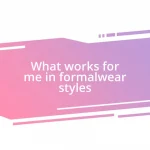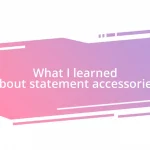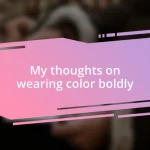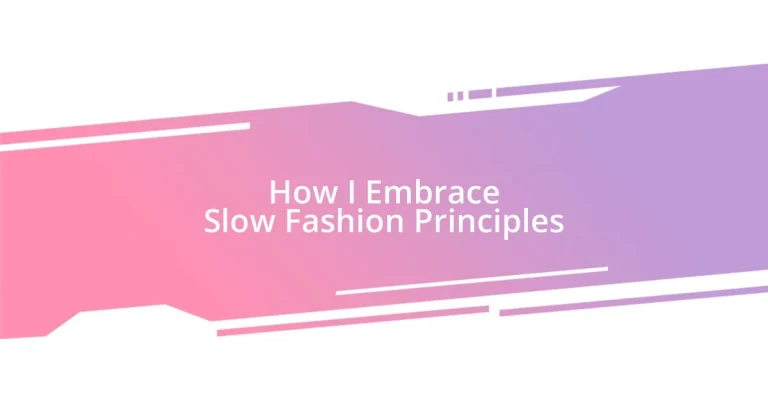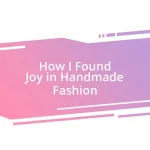Key takeaways:
- Slow fashion prioritizes quality, sustainability, and community engagement, shifting the mindset towards mindful consumption.
- Investing in timeless, ethically produced clothing leads to financial savings, emotional satisfaction, and a deeper connection to personal values.
- Supporting ethical brands and engaging in thrifting/upcycling fosters creativity, community connections, and a meaningful approach to fashion choices.
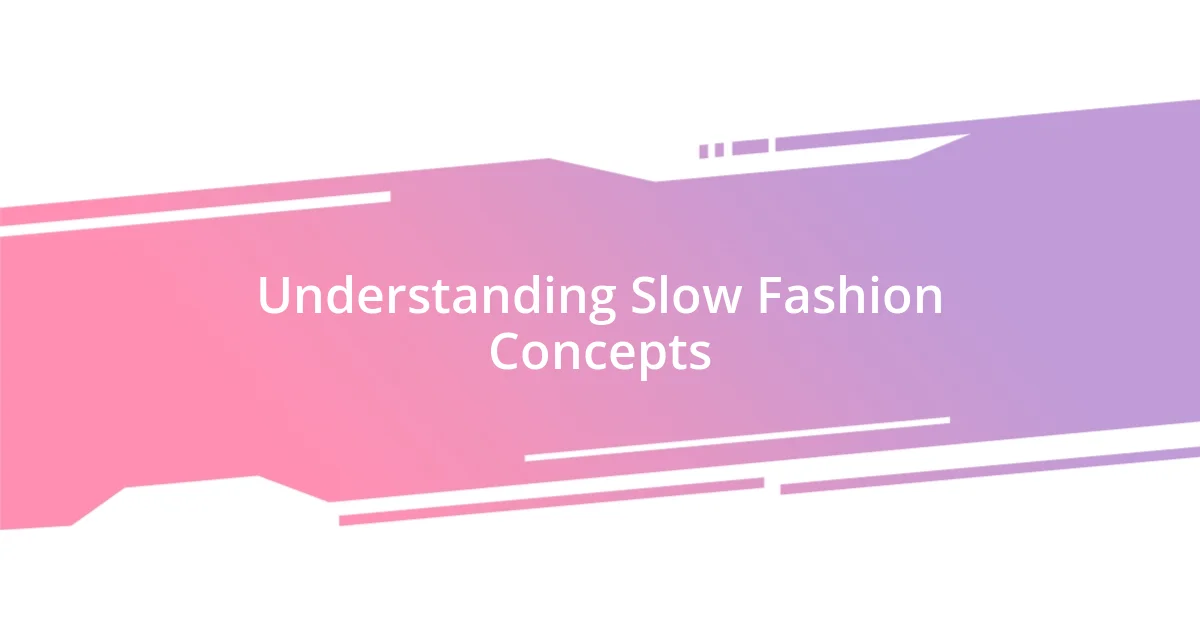
Understanding Slow Fashion Concepts
Slow fashion is all about valuing quality over quantity. I remember when I first made the choice to invest in a few high-quality pieces rather than filling my closet with fast fashion items. It was a shift in mindset—one that made me appreciate each item’s craftsmanship and story, making my wardrobe feel much more personal.
Another thing that resonates with me is the emphasis on sustainability in slow fashion. Have you ever looked at the label of a garment and felt a twinge of guilt about its origins? I used to feel that way, especially after learning about the harmful effects of fast fashion on our planet. Embracing slow fashion principles has led me to seek out brands that prioritize ethical practices, and this awareness feels empowering.
Moreover, the community aspect of slow fashion is incredibly enriching. I’ve found joy in connecting with like-minded individuals who share a passion for mindful consumption. Doesn’t it feel great to swap clothes, share tips, and build a wardrobe that reflects our values together? Each interaction deepens my commitment to slow fashion, transforming it into more than just a personal choice but a shared movement.
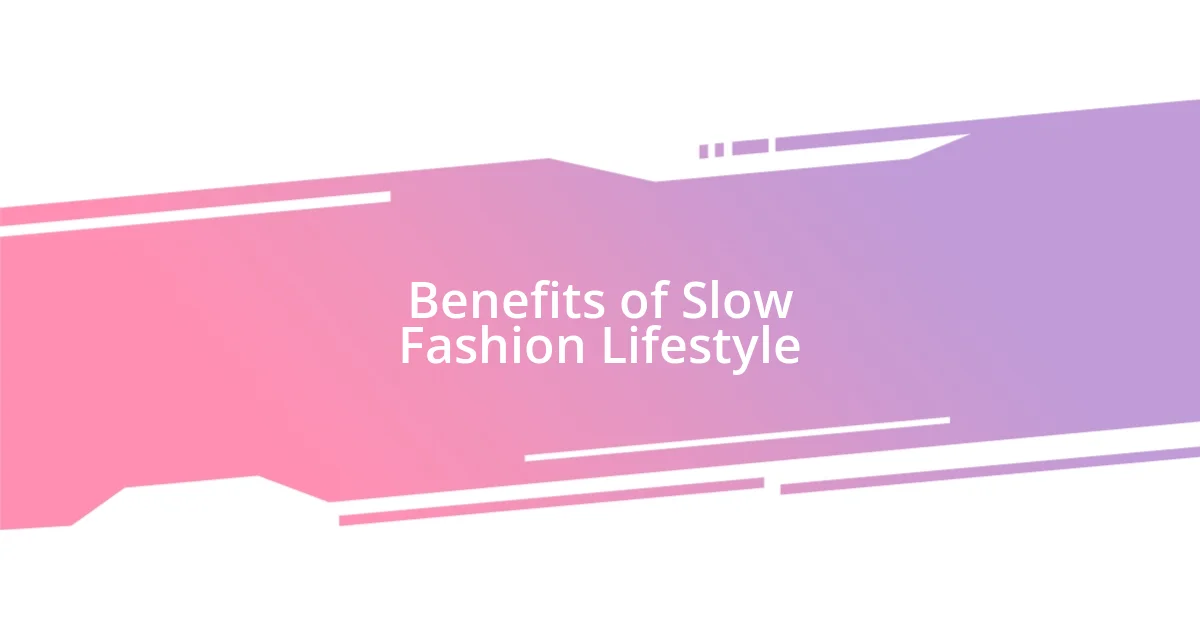
Benefits of Slow Fashion Lifestyle
Embracing a slow fashion lifestyle has opened my eyes to the financial benefits it brings. For instance, instead of spending money on numerous low-quality items, investing in a few timeless pieces has saved me money over time. I still remember the thrill of purchasing a beautifully made winter coat; it’s not just a coat, but an investment that keeps me warm for years.
Additionally, wearing clothing that I know is produced ethically gives me a sense of pride. There’s something truly satisfying about donning an outfit that aligns with my values. Comparatively, I used to feel a bit embarrassed about the origin of my clothes. Now, each piece I wear tells a story of sustainability and respect for people and the planet.
Lastly, slow fashion encourages a deeper connection to my wardrobe. I’ve started curating outfits based on how each piece makes me feel rather than simply how it looks. It transforms getting dressed into an experience rather than a routine. Have you ever felt excited about your clothing choices? I’ve discovered that this intentionality deepens my appreciation for fashion and fosters creativity.
| Benefit | Description |
|---|---|
| Financial Savings | Investing in quality items reduces the need for frequent purchases, leading to long-term savings. |
| Emotional Satisfaction | Wearing ethically produced clothing promotes a sense of pride and aligns with personal values. |
| Personal Connection | Intentional curation of outfits enhances appreciation and fosters creativity in fashion choices. |
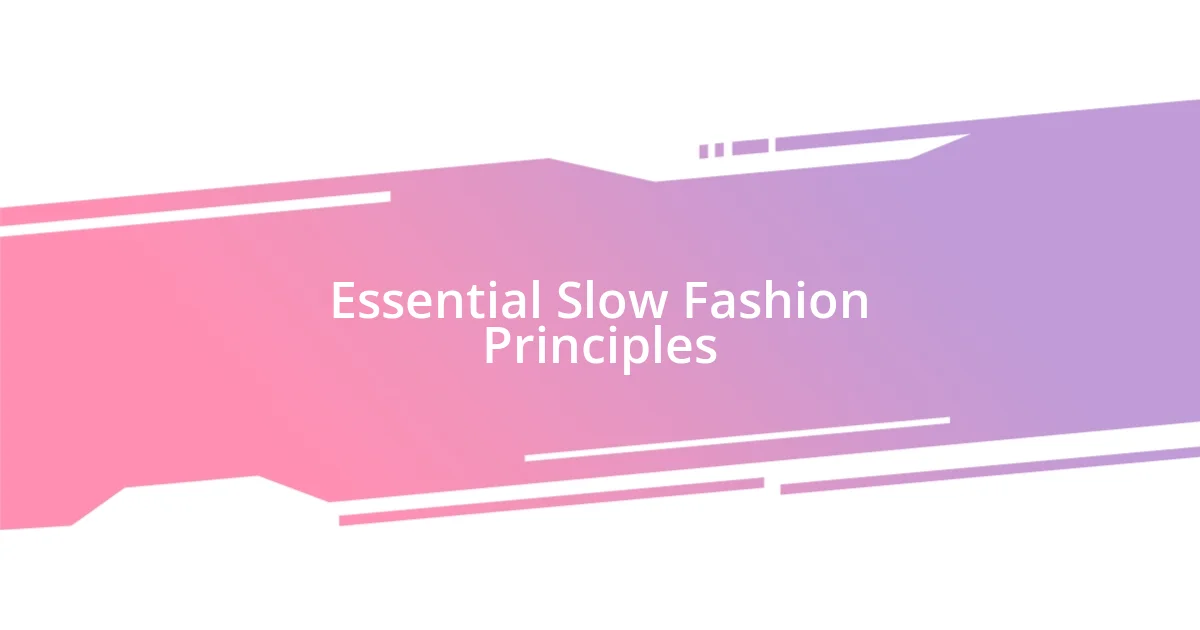
Essential Slow Fashion Principles
Embracing essential slow fashion principles has illuminated new paths for me. One key principle is the focus on timeless design—pieces that transcend trends. I recall buying a classic black dress that I’ve worn for countless occasions, from weddings to simple dinner dates. It’s incredible how a well-chosen piece can be so versatile, allowing me to express myself in myriad ways.
Here are some other essential principles that I’ve found helpful in guiding my slow fashion journey:
- Quality Craftsmanship: Prioritizing well-made clothing that lasts rather than fast fashion items that quickly wear out.
- Ethical Sourcing: Choosing brands that are transparent about their supply chains and prioritize fair labor practices.
- Reduced Consumption: Limiting purchases to truly needed items, emphasizing mindful shopping over impulsive buying.
- Repair and Reuse: Valuing the art of mending garments instead of discarding them, extending their lifespan and reducing waste.
- Second-Hand Shopping: Exploring thrift stores and online marketplaces for unique pieces that add character to my wardrobe.
Another principle I cherish is the commitment to sustainability. Each time I wear an outfit made from organic materials, I feel connected to a larger movement against environmental degradation. I still remember the thrill I felt when I found a pair of ethically made sneakers—they sparked not just joy but a sense of purpose. It’s these thoughtful choices that transform my wardrobe into an extension of my values, inspiring me to contribute positively to the world around me.
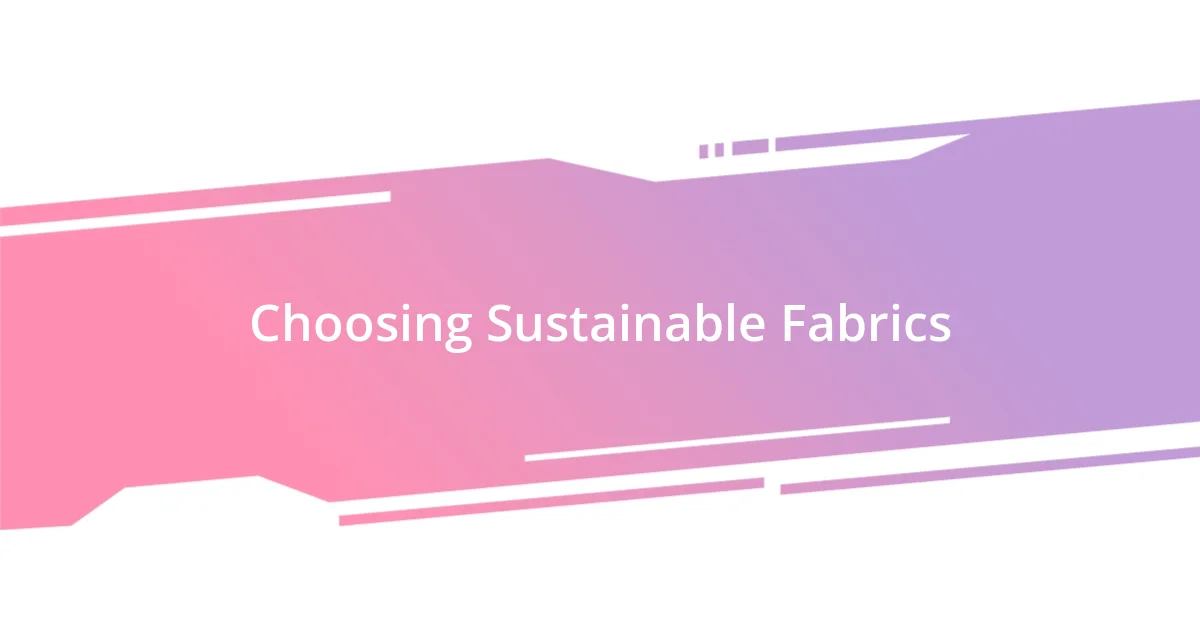
Choosing Sustainable Fabrics
Choosing sustainable fabrics can profoundly impact how we experience fashion, not just in terms of style, but in aligning our clothing choices with our values. I remember feeling a spark of excitement when I discovered linen—a fabric made from the flax plant. Not only is it biodegradable and requires fewer pesticides, but it also breathes beautifully. Wearing a linen shirt during hot summer days transforms my experience; it’s light, airy, and I can almost feel the Earth’s blessings as I wear something so natural.
When evaluating fabrics, I always consider the environmental footprint of my choices. For example, organic cotton piques my interest because it’s grown without harmful chemicals, safeguarding both the planet and the farmers. Every time I find a piece made from organic cotton, it feels like I’m supporting sustainable practices and making a conscious effort to protect our ecosystems. Have you ever paused to think about the journey your clothes make before they reach you? It’s a valuable question that can deepen our connection with our wardrobe and encourage us to opt for fabrics that are kinder to the Earth.
I also cherish exploring innovations in sustainable textiles, such as Tencel, which is derived from sustainably sourced wood pulp. I vividly recall stumbling upon a pair of Tencel pants that felt almost like wearing a gentle hug. They drape beautifully and are surprisingly soft, as if they were designed to accompany me through moments of joy and comfort. It reinforces my belief that choosing sustainable fabrics isn’t just about being environmentally responsible; it’s also about curating a wardrobe that enriches my life. Isn’t it incredible to wear something that resonates with our values while also making us feel amazing?
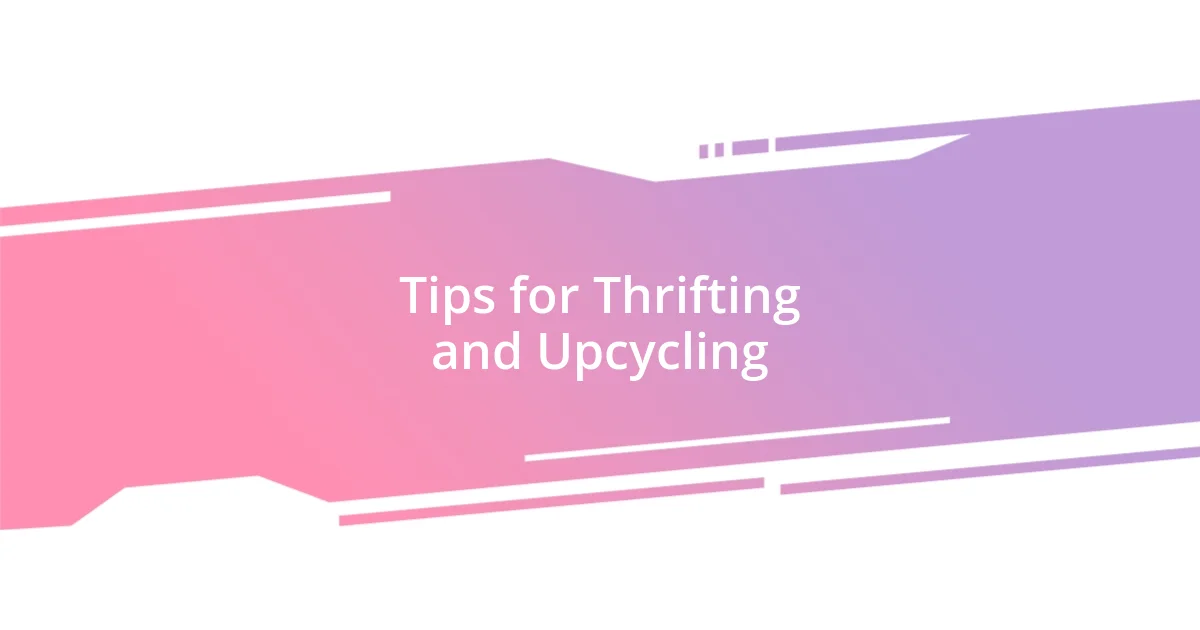
Tips for Thrifting and Upcycling
When I dive into thrifting, I approach it like an adventure; every trip feels like a treasure hunt. I always encourage stepping into thrift stores with an open mind and a willingness to explore beyond the obvious. I once stumbled upon a vintage denim jacket that felt like it had a story. Its faded patches and retro buttons gave it character, and I felt a sense of excitement knowing I was giving a new life to something someone once cherished.
Upcycling is equally rewarding. One day, as I sifted through a pile of discarded scarves, a vibrant floral piece caught my eye. Instead of letting it remain stagnant, I transformed it into a chic tote bag. It’s remarkable how a little creativity can elevate something seemingly forgotten into a unique accessory. Have you ever tried breathing new life into old items? That moment of realization—owning something truly original—brought me immense joy.
Lastly, I’ve found that connecting with local artisans or taking part in community workshops can be an enriching experience for upcycling enthusiasts. I remember attending a session where we learned to turn old T-shirts into reusable shopping bags. Sharing ideas with like-minded individuals and learning skills from each other was just as fulfilling as the final product. Isn’t it special how the act of creating can forge connections and cultivate a sense of community? It makes my journey into slow fashion not just personal but also shared.
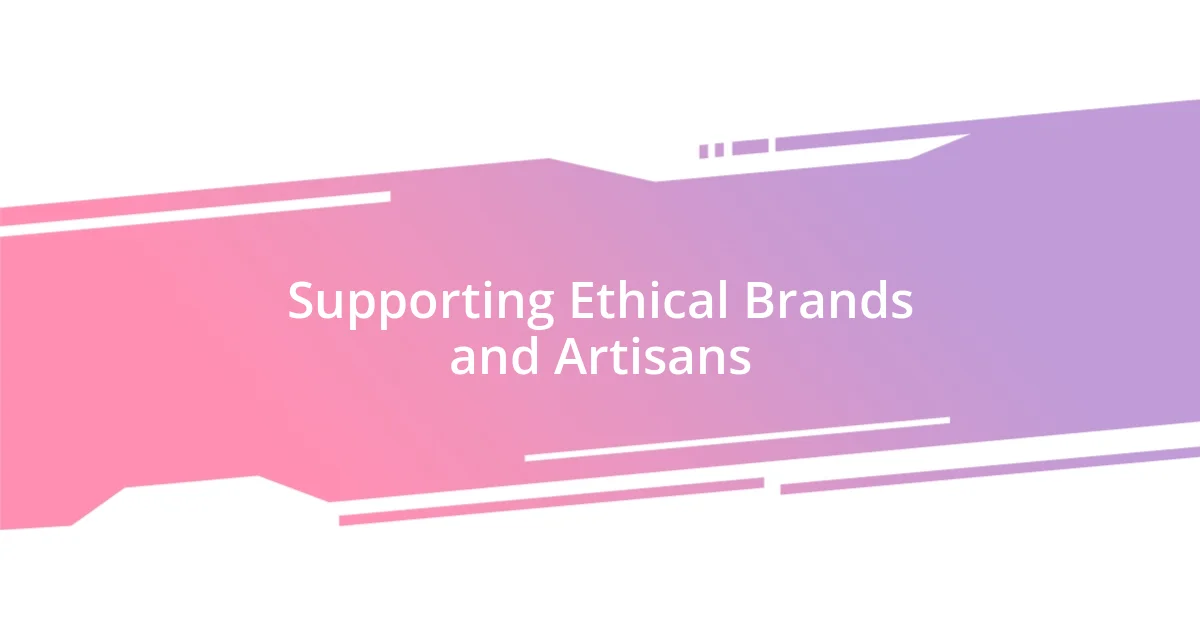
Supporting Ethical Brands and Artisans
Supporting ethical brands and artisans is not just a choice; it’s a commitment to a better future. When I first discovered a local fair-trade shop, I felt a thrilling connection to the artisans behind the goods. Knowing that my purchase directly supports families and communities was like a warm hug, reminding me that every dollar spent holds power. Have you ever thought about how the story behind your clothing can enrich your experience?
I vividly remember visiting a craft fair featuring handmade designs from local artisans. One booth caught my eye: a woman passionately selling handwoven scarves crafted from ethically sourced materials. As I chatted with her, she shared the labor and love that went into each piece. That day, I realized that choosing to support artisans transcends mere consumption; it’s about investing in creativity and sustainability. Isn’t it amazing to think that your wardrobe can be a canvas that showcases not just style but also a philosophy?
Furthermore, I often find myself examining the narratives woven into the products I purchase. A few months ago, I bought a beautifully crafted bag made from recycled materials. Each time I use it, I think about the journey those materials took and the hands that shaped them. This perspective makes me appreciate not just the aesthetics, but also the meaningful impact of supporting brands with ethical practices. What if our shopping habits could help us tell stories of hope and resilience with every outfit we wear?


